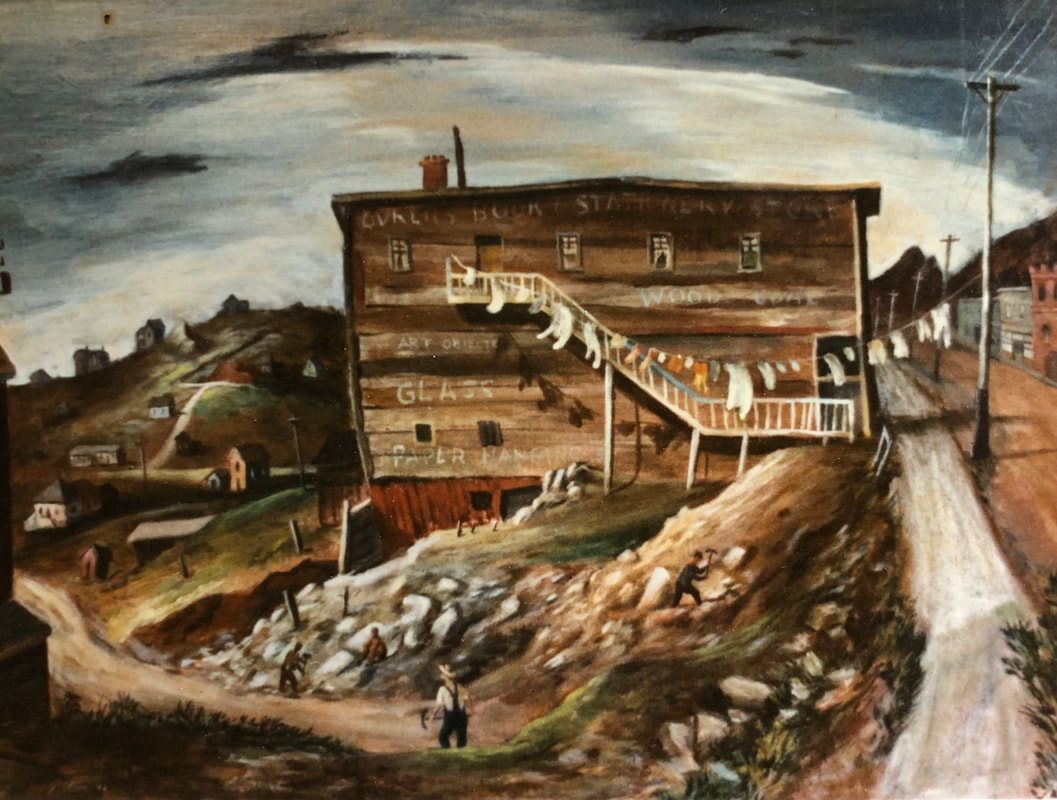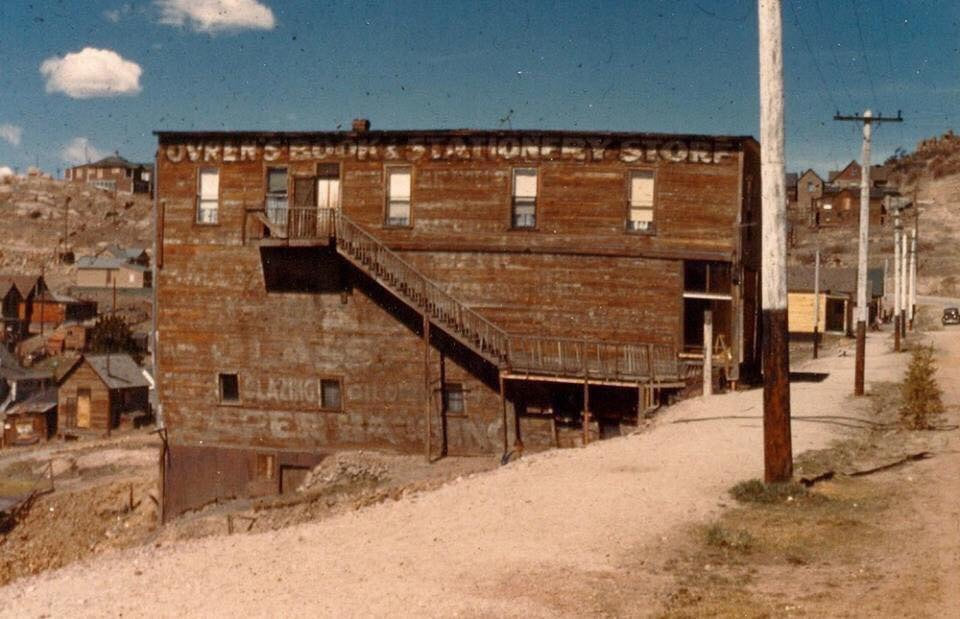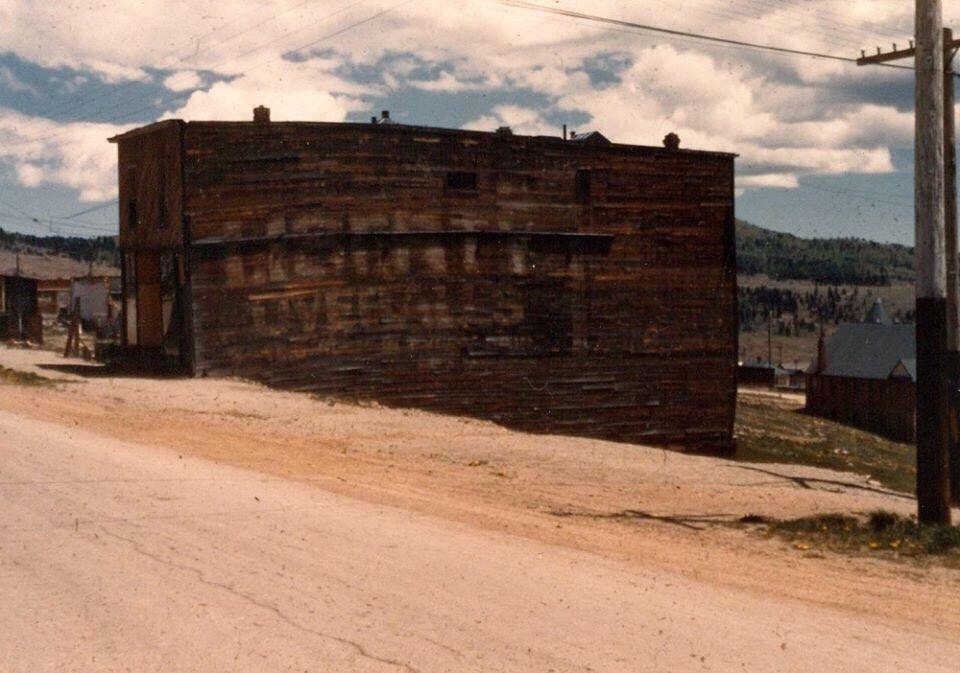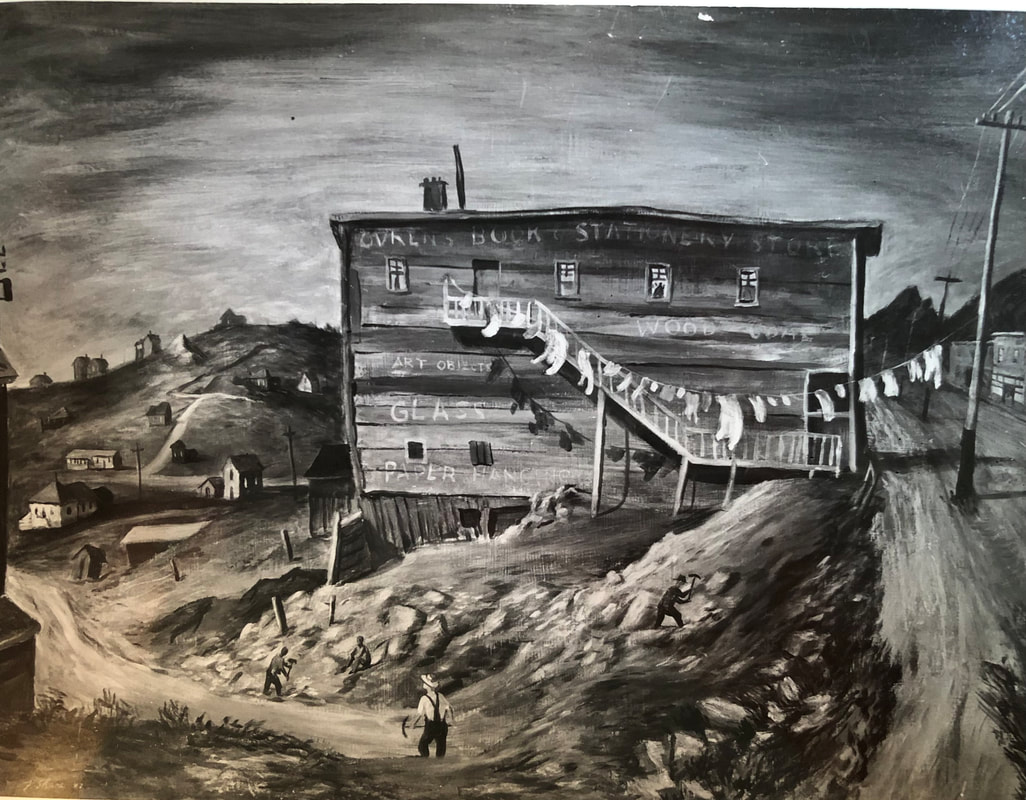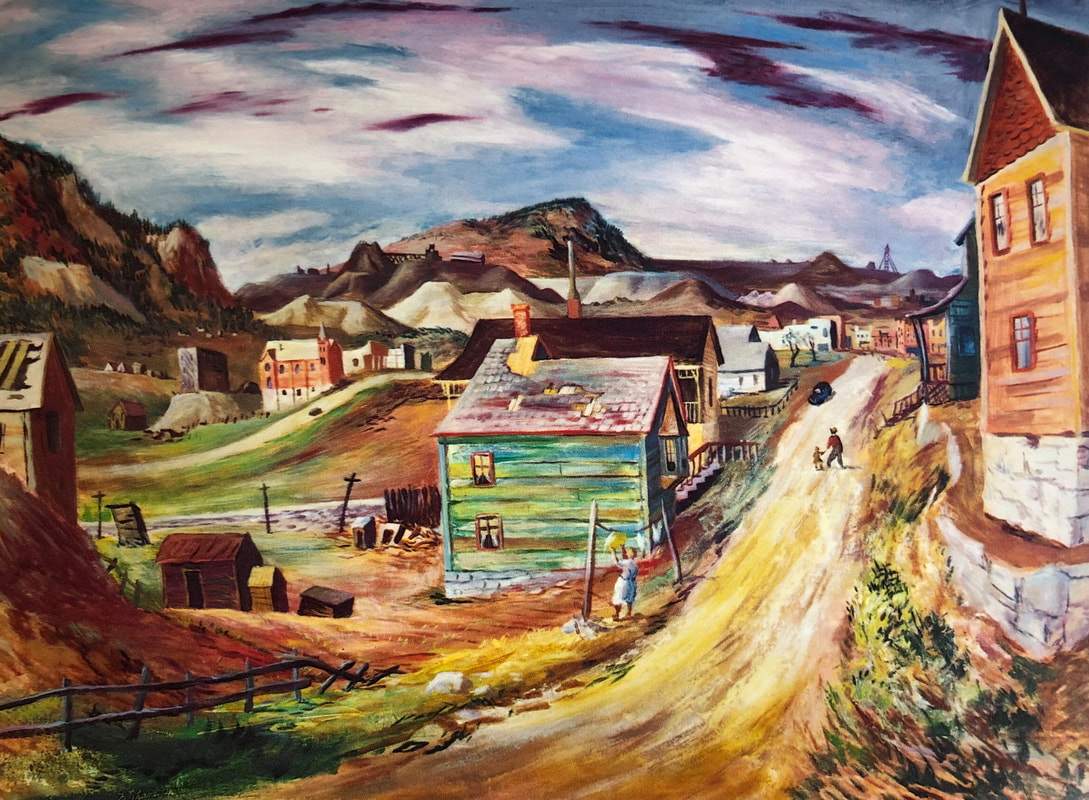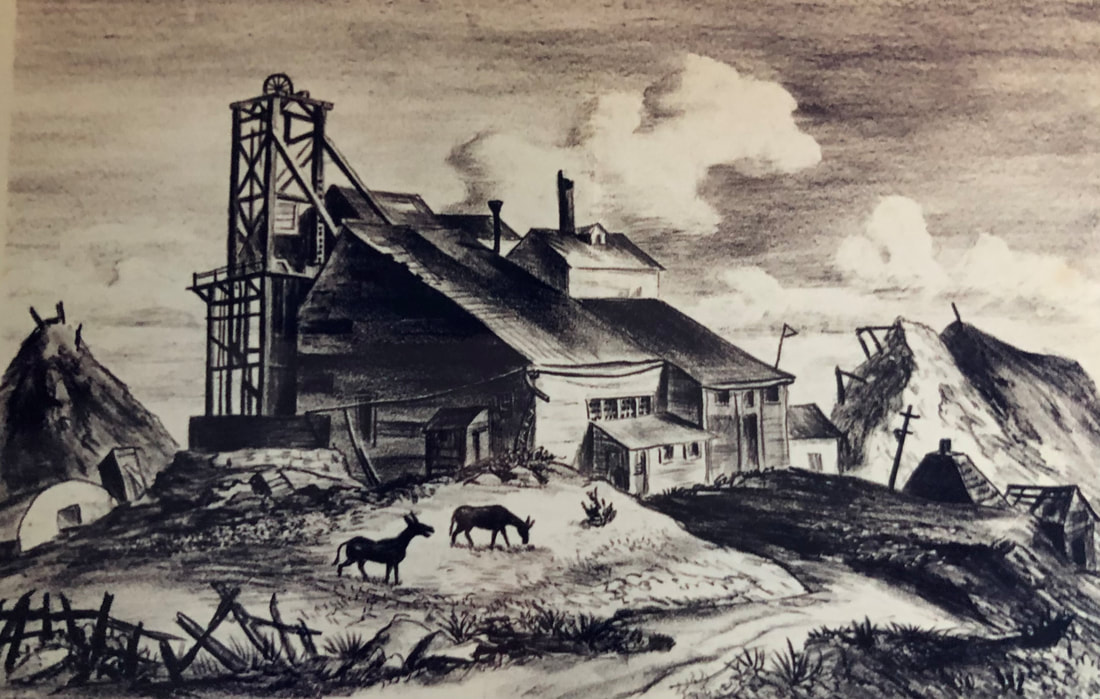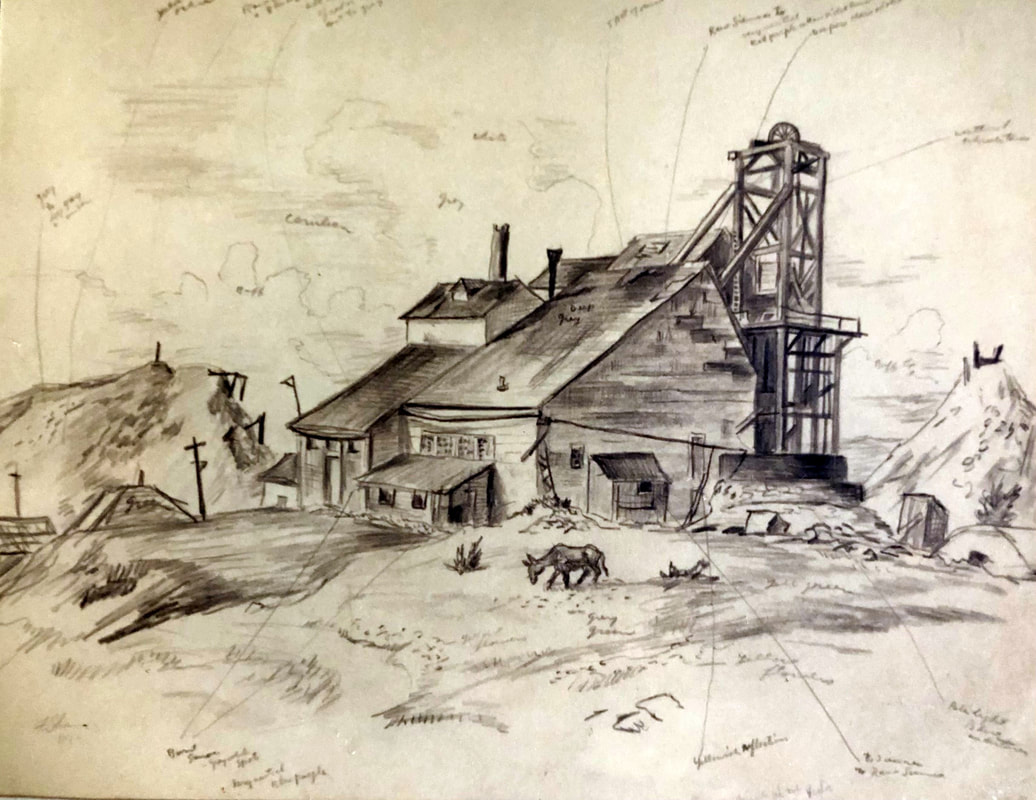Photo Gallery of Historic Victor Artwork by Fred Shane, Circa 1942
Shown below are photos of artwork shared by Claudia Lohnes. Claudia is curating the paintings and other works created by her grandfather, Fred Shane, an accomplished "regionalist" painter who found compelling subject matter for some of his artwork in Victor, Colorado during the early 1940's.
Claudia discovered a photo of Ovren's Book & Stationary Store, a building portrayed by one of her grandfather's paintings, on the Victor Heritage Society website. She would like to know more about the history of this building and acquire additional background information about the subject matter portrayed in Fred Shane's other Victor paintings. Let us know what you see by emailing [email protected].
Claudia discovered a photo of Ovren's Book & Stationary Store, a building portrayed by one of her grandfather's paintings, on the Victor Heritage Society website. She would like to know more about the history of this building and acquire additional background information about the subject matter portrayed in Fred Shane's other Victor paintings. Let us know what you see by emailing [email protected].
TWO DEPICTIONS OF ORVEN'S BOOK & STATIONARY STORE
Shared Comments & Observations About Fred Shane's Painting of Ovren's Building:
- Ovren’s Book & Stationary Store was located in the 500 block of Victor Avenue across from the City Hall. E.M. Ovren moved his business from Leadville to Aspen in 1894, and from there to Victor around the turn of the century.
- From Georganna McCleerey Peiffer: This painting brings back memories of when I grew up in Victor and delivered newspapers to Mrs. Ovren. I was rewarded with an extra nickle or dime for taking the paper up to the door on the landing of her second story living quarters (three stories above the ground at the back of the old wooden building). I stayed as close to the building as possible while carefully tiptoeing up and down the rickety stairs attached to the side of the building. Old Mrs. Ovren was a kind and generous woman, but I was not inclined to linger as the building sometimes seemed to shift with the wind. I was eager to get safely back to the street level where the entrance to Ovren's Store was located. I did put my fears aside to help Mrs. Ovren with her household chores, pealing potatoes and such, when she had an accident and broke her arm. In those days neighbors and friends helped each other whenever there was a need. My family lived nearby in the 600 block of Victor Avenue.
- After the Great Fire of August 22, 1899 devastated most of Victor's Downtown Business District, the city quickly adopted new ordinances calling for the use of more fire-proof brick and stone construction materials when rebuilding commenced at a fast and furious pace. Thus one might speculate that Ovren's wooden building was constructed before the fire and it survived the flames that destroyed so many other structures. Fred Shane's 1942 painting illustrates Ovren's building was constructed of wood (not brick), and also depicts the rickety conditions that Georganna McCleerey Peiffer remembers.
- Available Evidence: The 1900 City Directory indicates E.M. Ovren's "Paints & Oils Business" was located at 107 N 3rd Street; the 1902 & 1905 Directories show his "Books, Stationary, Wall Paper, Paints & Oils Business" relocated to the building at 500 Victor Ave. Sanborn Fire Insurance Maps for 1900 show no building at this location; in 1908 & 1919 Ovren's "Stationary & Wall Paper" building is shown at 500 Victor Ave. A photo, circa 1901, shows Ovren's wooden building and the brick Baptist Church still under construction. A newspaper article in the Times Record (Aug 8, 1947, Kenneth Geddes, editor) reports "the Ovren building was sold several weeks ago to wreckers who are now at work tearing it down. For many years the school children of Victor went to Ovren's for their school supplies. For the past fifteen years or more the two story wooden building has listed more and more to the east, and recently residents of the town have eyed it anxiously during every high wind. Mr. Ovren, in failing health for some time, had expressed the desire to live out his days in his old home, which was on the second floor. He died several months ago and Mrs. Ovren moved to Denver with her daughter, Mrs. Marie Hawthorne. Since that time, the building, seeming to feel that it has outlived its usefulness, has sagged more and more. The wreckers state, however, that the timbers of its foundation are unusually large and strong and in good condition." [Evidence and comments shared by La Jean Greeson and Steve Plutt.]
- After the fire, a new red brick City Hall was erected on Victor Avenue. Notice to the far right in Fred Shane's 1942 painting, there is a small portion of the red brick Victor City Hall that was constructed in 1900 across the street from Ovren's building.
- Consistent with the advertising for coal and wood depicted in the painting, Fred Shane's artwork shows a pile of coal at the back of the building. In the gulch below street level the painting also depicts four men–one with an axe for chopping wood, two with picks for breaking up chunks of coal, and one sitting on the ground resting.
- A photo of Ovren's building that Claudia Lohnes found on the Victor Heritage Society website (shown below) was shared by Jim Davidson. It was used to illustrate the building in two stories available in our on-line Oral History Archives: "Seven Generations in Victor, Colorado & the Mining District--The Way It Was: Installment 2"; and "A History of Victor Colorado" published by S.E. Poet wherein it was noted that "Ovren's Book & Stationary Store supplied books and writing materials and also offered a fine selection of wall paper and provided skilled paper hangers." E.M. Ovren was still in business in 1933 when Poet was Superintendent of Public Schools in Victor and his "History of Victor" was compiled.
- Shown below are photos of the east and west facades of Ovren's Book & Stationary Store.
Claudia Lohnes also found a black and white version of Fred Shane's portrayal of Ovren's Book & Stationary Store (shown below). Shane's two paintings are similar, but not identical. Both employ some degree of "artistic license". The Victor City Hall is actually located in the middle of where North Fifth Street would be if it came through to Victor Avenue. Ovren's building, on the opposite side of Victor Avenue, was actually located to the west of where South Fifth Street would have connected to Victor Avenue. Georganna McCleerey Pheiffer does not recall a clothes line running along the stairway of the building, but that certainly adds a very nice touch to portraying the "character" of the building and people who lived there.
PAINTING OF OLD ROAD THROUGH VICTOR, COLORADO
Comments & Observations About The Location & The Buildings In The Painting:
- The painting appears to be executed from near the bottom of South Third Street in Victor, Colorado--extending north toward the mine dumps and head-frames (gallows frames) on Battle Mountain.
- It depicts a woman hanging clothes on left side of 3rd St, a child with an adult walking north up 3rd St, and a car coming down 3rd St.
- On the Battle Mountain horizon above North Third Street appears to be the head-frame (gallows frame) for the Portland #1 Mine Shaft (which still stands today).
- On the right and left sides of South Third Street are homes similar in appearance to those that once lined this street, but not necessarily identical or in the same location as the homes that remain standing there today.
- At center left, the red brick Baptist Church is clearly identifiable at the Corner of South Fourth Street & Portland Avenue. This is the only remaining original church that continues to hold regular services in Victor.
- A car is depicted coming down South Fourth Street below the Baptist Church. This section of S 4th St is no longer passable.
- Above the Baptist Church on South Fourth Street appears to be the columns of the iconic Christian Science Church building, which was condemned and torn down in November of 2000. For photos of the Christian Science Church, click the highlighted link and scroll toward the bottom of the page to a section titled "Lost Victor Landmarks--Gone Forever, But Not Forgotten".
- The tall, narrow, dark brown building to the left of the Baptist Church most likely depicts the back of Ovren's Building depicted in the first Fred Shane painting.
- On the horizon above North Fourth Street are mine dumps and surface structures that depict the Ajax Mine.
TWO DEPICTIONS OF AN OLD MINE IN VICTOR
Comments & Observations About the Painting Titled "OLD MINE" IN VICTOR:
- This "Old Mine" in Victor appears to be a depiction of Winfield Scott Stratton's Independence Mine. The site has changed considerably since the early 1940's when the Fred Shane produced his lithograph and most likely exercised some degree of "artistic license" in depicting the site.
- Gary Horton believes VIEW #1 of Fred Shane artwork portrays the Independence Mine head-frame viewed from slightly above today's Battle Mountain Trail looking from the NW toward the SE. Today the trommel (ore sorting) display on the trail is to east of powder magazine (round-topped structure) at the left of the photo. Further to left (east and out of sight in the photo) is the SW part of old Independence Mill site with ruins that are still visible today.
- In his younger days, Gary explored and worked in several of the underground gold mines near Victor. After earning a degree in geology, Gary returned to the Mining District and was employed by several parent companies of the Cripple Creek & Victor Mining Company's surface mining operations. Now retired, Gary serves as a tour guide at the Molly Kathleen Tourist Mine near Cripple Creek and volunteers his mining and historical expertise to make presentations about the Cripple Creek & Victor Mining District.
- After Gary commented on the painting shown above, Claudia found the related sketch shown below.
Additional comments from Gary Horton after seeing the sketch:
- There's a similarity in the buildings in the painting and the sketch, but the perspectives are confusing. If we were looking from the opposite side, the headframe would be on the other side of the building. It makes me think the artist took some license?
- Also the Independence has two sheave wheels (the wheels on top), and there’s no gantry (which is a kind of a cherry picker) on the top of the headframe.
- My guess is that the artist used the Independence Mine as a “model” and added stuff not intending to replicate it entirely realistically.
Click the highlighted links below for more information and photos.
- Stratton's Independence Mine & Mill Site was listed on the National Register of Historic Places in 1993.
- A Preservation and Restoration Project at the Site was completed in 2017-18 when segments of the massive head-frame were taken down, strengthened, and reassembled.
ABOUT THE ARTIST:
FREDRICK SHANE (1906-1990) was a regionalist, surrealist, muralist, and long-time teacher at the University of Missouri where he became head of the Art Department. [1] In 1932 Shane began teaching at the University of Missouri at Columbia; he was appointed Art Department Chairman in 1958, and he retired in 1971. [1] Influenced by American Regionalist painters, his paintings explored the beauty of the everyday, elevating abandoned and isolated scenery to expressive works of art. [3] His early studies were in Colorado Springs and he often vacationed there. [4]
Frederick Emanuel Shane was born on February 2, 1906, in Kansas City, Missouri. He began painting portraits and landscapes at the age of eight, and by age seventeen he was enrolled at the Kansas City Art Institute. [3] In the summers of 1925-26 Shane studied at the recently-founded Broadmoor Academy in Colorado Springs. The Academy was established in 1919 by Spencer and Julie Penrose, prominent philanthropists and art patrons, who donated their family residence for the creation of a local art institution. [2] From 1939 to 1944, Shane summered in Colorado. [1]
His Colorado sketching trips resulted in drawings whose imagery appeared in some of Shane’s prints and paintings, such as his oil on canvas, Owen’s Bookstore, Victor, Colorado (1942). [2] Some of his most notable paintings of the 1940's depict Colorado subjects in his consummate regionalist style. [2]
Fredrick Shane developed a unique painting style focused on everyday subjects. He was drawn to abandoned mining towns, isolated rural landscapes, and scenes of working-class urban life. [3] Thanks to Claudia Lohnes for sharing photos of her grandfather's paintings and artworks depicting Victor, Colorado in the 1940's! This represents only a small portion of a large collection of paintings for which he is known and have been exhibited at the Whitney Museum of American Art in New York, the Corcoran Gallery in Washington, D.C., the New York World's Fair, the State Historical Society of Missouri, and many other major venues. [3]
1. ARTFIXdaily.com, Oct 10, 2010. https://www.artfixdaily.com/artwire/release/936-fred-shane-paintings-1928-to-1980
2. 1stdibs.com, https://www.1stdibs.com/creators/frederick-shane/art/
3. Missouri Artists, https://www.1stdibs.com/creators/frederick-shane/art/
4. Invaluable.com, https://www.invaluable.com/auction-lot/fred-shane-1906-1992-pencil-signed-lithograph-108-c-09240598f9
FREDRICK SHANE (1906-1990) was a regionalist, surrealist, muralist, and long-time teacher at the University of Missouri where he became head of the Art Department. [1] In 1932 Shane began teaching at the University of Missouri at Columbia; he was appointed Art Department Chairman in 1958, and he retired in 1971. [1] Influenced by American Regionalist painters, his paintings explored the beauty of the everyday, elevating abandoned and isolated scenery to expressive works of art. [3] His early studies were in Colorado Springs and he often vacationed there. [4]
Frederick Emanuel Shane was born on February 2, 1906, in Kansas City, Missouri. He began painting portraits and landscapes at the age of eight, and by age seventeen he was enrolled at the Kansas City Art Institute. [3] In the summers of 1925-26 Shane studied at the recently-founded Broadmoor Academy in Colorado Springs. The Academy was established in 1919 by Spencer and Julie Penrose, prominent philanthropists and art patrons, who donated their family residence for the creation of a local art institution. [2] From 1939 to 1944, Shane summered in Colorado. [1]
His Colorado sketching trips resulted in drawings whose imagery appeared in some of Shane’s prints and paintings, such as his oil on canvas, Owen’s Bookstore, Victor, Colorado (1942). [2] Some of his most notable paintings of the 1940's depict Colorado subjects in his consummate regionalist style. [2]
Fredrick Shane developed a unique painting style focused on everyday subjects. He was drawn to abandoned mining towns, isolated rural landscapes, and scenes of working-class urban life. [3] Thanks to Claudia Lohnes for sharing photos of her grandfather's paintings and artworks depicting Victor, Colorado in the 1940's! This represents only a small portion of a large collection of paintings for which he is known and have been exhibited at the Whitney Museum of American Art in New York, the Corcoran Gallery in Washington, D.C., the New York World's Fair, the State Historical Society of Missouri, and many other major venues. [3]
1. ARTFIXdaily.com, Oct 10, 2010. https://www.artfixdaily.com/artwire/release/936-fred-shane-paintings-1928-to-1980
2. 1stdibs.com, https://www.1stdibs.com/creators/frederick-shane/art/
3. Missouri Artists, https://www.1stdibs.com/creators/frederick-shane/art/
4. Invaluable.com, https://www.invaluable.com/auction-lot/fred-shane-1906-1992-pencil-signed-lithograph-108-c-09240598f9
In 1999 a nonprofit organization known as "Victor Celebrates the Arts" was formed to sponsor an annual En Plein Air Art Show & Sale each Labor Day Weekend that typically attracts 50-60 artists from around the county who paint on-site within a 10 mile radius of the Victor City Hall. For over two decades the participating artists have been painting various scenes in and around Victor and at many nearby legendary 1890's gold mining sites. Among many the Juried and Special Awards, the Victor Heritage Society sponsors two annual awards for paintings that best represent Victor's Heritage. Perhaps at some future date the work of some of these artists will be curated and commented on for their ability capture and preserve the historical character of the area as it still existed in the early 21st Century?
Some people say,
"In a small town there is not much to see, but what you hear makes up for it."
In historic Victor, Colorado there is plenty to see and hear.
Come take a look--and a listen!
"In a small town there is not much to see, but what you hear makes up for it."
In historic Victor, Colorado there is plenty to see and hear.
Come take a look--and a listen!
Click Here for a Photo Gallery: Victor Residential Gems
Click Here for a Photo Gallery of Historic Victor Homes & Buildings--Then & Now
Click Here for a Photo Gallery: Historic Underground Gold Mines Near Victor
Click Here to View a Booklet: Guide to Preserving Our Architectural Heritage
VictorHeritageSociety.com
Copyright © 2023 Victor Heritage Society. All Rights Reserved.
Copyright © 2023 Victor Heritage Society. All Rights Reserved.
